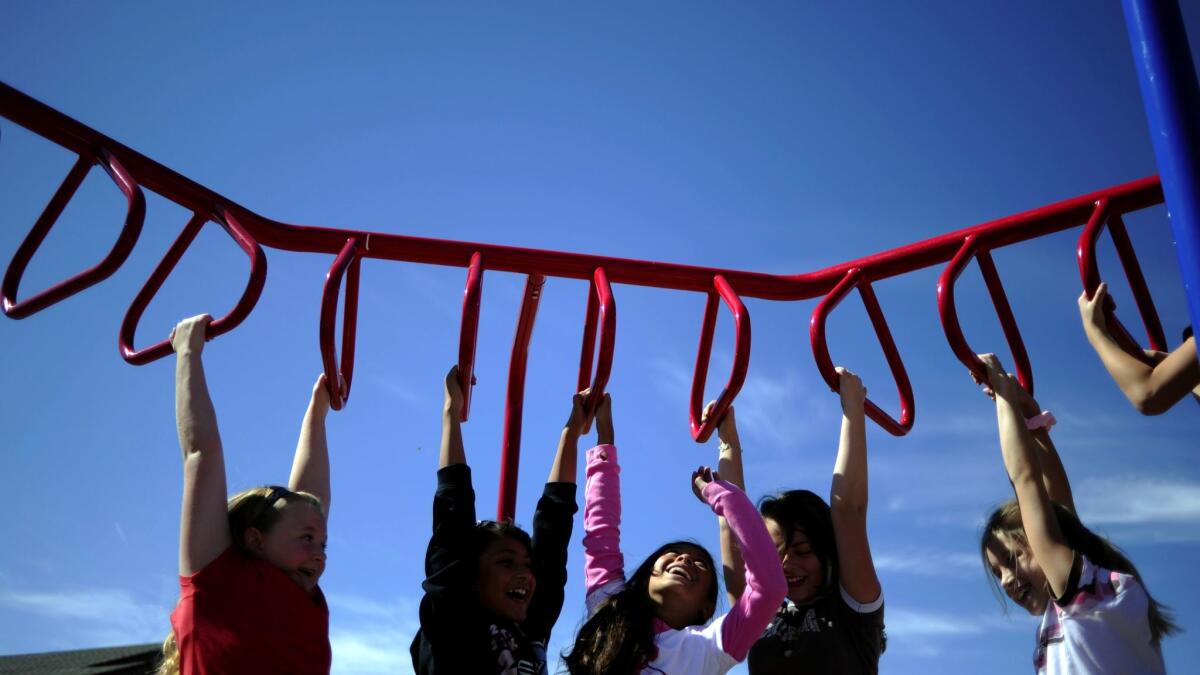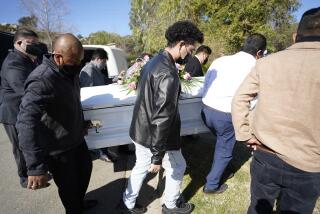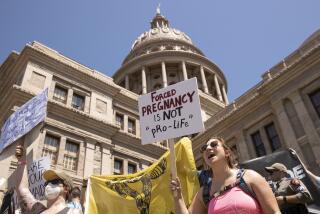Why the United States is ‘the most dangerous of wealthy nations for a child to be born into’

- Share via
It’s no surprise that the United States ranks absolutely last in child mortality among the world’s wealthiest countries — that’s been true for years. A new study examines how this sad situation came to be.
According to data from the World Health Organization and the global Human Mortality Database, the problems go all the way back to the 1960s. It was during that decade that the U.S. infant mortality rate (for babies less than a year old) and the U.S. childhood mortality rate (for those between the ages of 1 and 19) began to exceed the combined rates for the other 19 richest nations.
If the United States had performed as well as its peer countries between 1961 and 2010, more than 600,000 childhood deaths could have been avoided over those 50 years, the study authors concluded.
The results were published Monday in the journal Health Affairs.
“The care of children is a basic moral responsibility of our society,” wrote the study authors, led by Dr. Ashish Thakrar, a first-year resident in internal medicine at Johns Hopkins Hospital in Baltimore. “The U.S. outspends every other nation on health care per capital for children, yet outcomes remain poor.”
And things could soon get even worse, the authors added: The Trump administration’s budget includes “substantial cuts to the Children’s Health Insurance Program, which covers seven million children, and to the Supplemental Nutrition Assistance Program, which directs three-quarters of its benefits to households with children.”
But there’s plenty of evidence that things were bad already. Babies born in the United States have a lower life expectancy than their counterparts in other countries. In part, that’s because they face higher rates of obesity, injury, HIV infection and teen pregnancy, according to a 2013 report from the U.S. Institute of Medicine.
The US [is] the most dangerous of wealthy nations for a child to be born into.
— Dr. Ashish Thakrar and coauthors of a new study on childhood mortality
Thakrar and his colleagues compared the U.S. to the other countries in the Organization for Economic Cooperation and Development, or OECD. These countries — Australia, Austria, Belgium, Canada, Denmark, Finland, France, Germany, Iceland, Ireland, Italy, Japan, the Netherlands, New Zealand, Norway, Spain, Sweden, Switzerland and the United Kingdom — are similar to us in terms of “economic development and political structure,” they wrote. They dubbed this collection the OECD19.
Then they compared the U.S. to the OECD19 using two separate data sources.
The first was the Human Mortality Database, which takes census data, population estimates and vital statistics from 38 countries and uses them to compute mortality rates for different age groups. The HMD is maintained by UC Berkeley and the Max Planck Institute for Demographic Research in Germany.
The second was the WHO Mortality Database, which tracks both mortality and causes of death according to age and sex for the 114 countries that belong to the World Health Organization. The researchers grouped all possible causes of death into nine categories: infectious diseases; cardiovascular disease; cancer; neuropsychiatric conditions; other noncommunicable diseases (such respiratory conditions or diabetes); congenital problems; perinatal conditions that occur during pregnancy or the early days of life; and both intentional and accidental injuries.
Neither source contained information that allowed the researchers to account for differences in childhood mortality due to racial, income or other socioeconomic disparities.
In 1961, the number of children and teens in the OECD19 (144 million) was twice as high as in the U.S. (71 million). By 2010, that gap had closed substantially, to 112 million and 83 million, respectively.
At the start of the study period, the U.S. had lower rates of both infant mortality and childhood mortality. And the U.S. and the OECD19 saw steep declines in their mortality rates over the 50-year period.
But the gains in the OECD19 overtook those in the U.S. pretty quickly, the researchers found.
In the 1960s, the infant mortality rate in the U.S. was 240.7 deaths per 10,000 infants, compared with 250.3 deaths per 10,000 in the OECD19. By the 1970s, that discrepancy had flipped, with 147.1 deaths per 10,000 in the OECD19 and 157.4 per 10,000 in the U.S. In the last decade of the study (2001 to 2010), the infant mortality rate in the U.S. was down to 68.8 deaths per 10,000, but that was 76% higher than the OECD19 rate of 39 deaths per 10,000.
The situation was similar for childhood mortality. During the 1960s overall, both the U.S. and the OECD19 experienced 6.7 deaths per 10,000 among kids and teens ages 1 to 19. In the 1970s, the OECD19 had the edge, with 5.3 deaths per 10,000 compared with 6.2 deaths per 10,000 in the U.S. And in the 2000s, the U.S. childhood mortality rate of 3.1 deaths per 10,000 was 55% higher than the OECD rate of 2 deaths per 10,000.
The more time that passed, the larger the number of excess deaths in the U.S. became. During the 1960s, the excess deaths were actually in the OECD19, which suffered 32,500 of them. But in the 1970s, there were 95,900 infant and childhood deaths in the U.S. that would have been avoided if the U.S. had experienced the same mortality rates as the OECD19. In the 1980s, that figure rose to 163,000, then to 189,000 in the 1990s and finally 207,300 in the 2000s.
Adding it all up, the total number of excess deaths experienced by American infants, children and teens was about 622,7000, the researchers calculated. Nearly all of those deaths (90%) were in infants or teens between age 15 and 19, they added.
The care of children is a basic moral responsibility of our society.
— Dr. Ashish Thakrar and coauthors of a new study on childhood mortality
When comparing the U.S. against the 19 members of the OECD19 individually, Thakrar and his colleagues found that the U.S. ranked 14th out of 20 countries in the 1960s and ’70s, 19th out of 20 countries in the 1980s, and last in the 1990s and 2000s.
“There is not a single category for which the OECD19 had higher mortality rates than the US over the last three decades of our analysis,” the researchers wrote.
A few specific causes of death were noteworthy, the researchers wrote.
The leading cause of death among U.S. infants was extreme immaturity, and this was three times more likely to affect American infants than those born in the OECD19 nations. The No. 2 cause of infant mortality in the U.S. was sudden infant death syndrome; the risk of SIDS was 2.3 times higher here than in the OECD19.
For teens ages 15 to 19, the leading cause of death in the U.S. was motor vehicle accidents, and these were twice as deadly in the U.S. than in OECD19. The second-leading cause of death was firearm assaults, and the risk of gun deaths was 82 times higher in America than in the peer nations.
The study authors said their findings support the conclusions of the Institute of Medicine, which blamed a fragmented health system, poverty, a weak social safety net and other factors for “poor health outcomes” in the U.S. Thakrar and his team found that the disadvantages in the U.S. compared with the OECD19 arose in the late 1960s and the mid-1980s, “precisely the time when relative socioeconomic status for children fell in the US compared to other wealthy countries.”
Although the U.S. had higher per-capita spending on healthcare, it “spent significantly less of its gross domestic product per capital on child health and welfare programs, compared to other wealthy nations,” the researchers noted.
The result is that the United States is “the most dangerous of wealthy nations for a child to be born into,” the study authors concluded. “All US policy makers, pediatric health professionals, child health advocates, and families should be troubled by these findings.”
To read this article in Spanish, click here
Follow me on Twitter @LATkarenkaplan and “like” Los Angeles Times Science & Health on Facebook.
MORE IN SCIENCE
In rural China, calling someone a ‘witch’ has serious social consequences
No, it’s not too late to get a flu shot
Even if you don’t know you’re sick yet, your face will give you away







